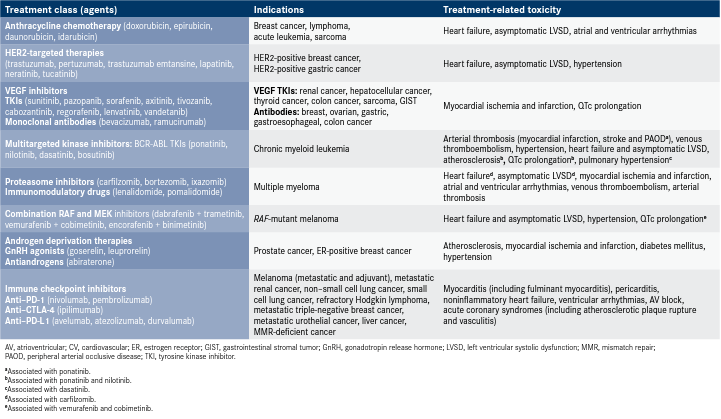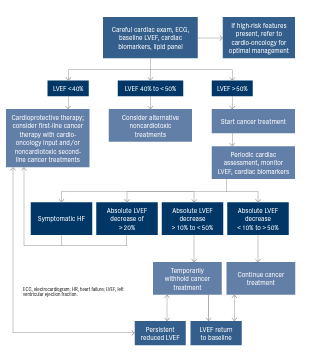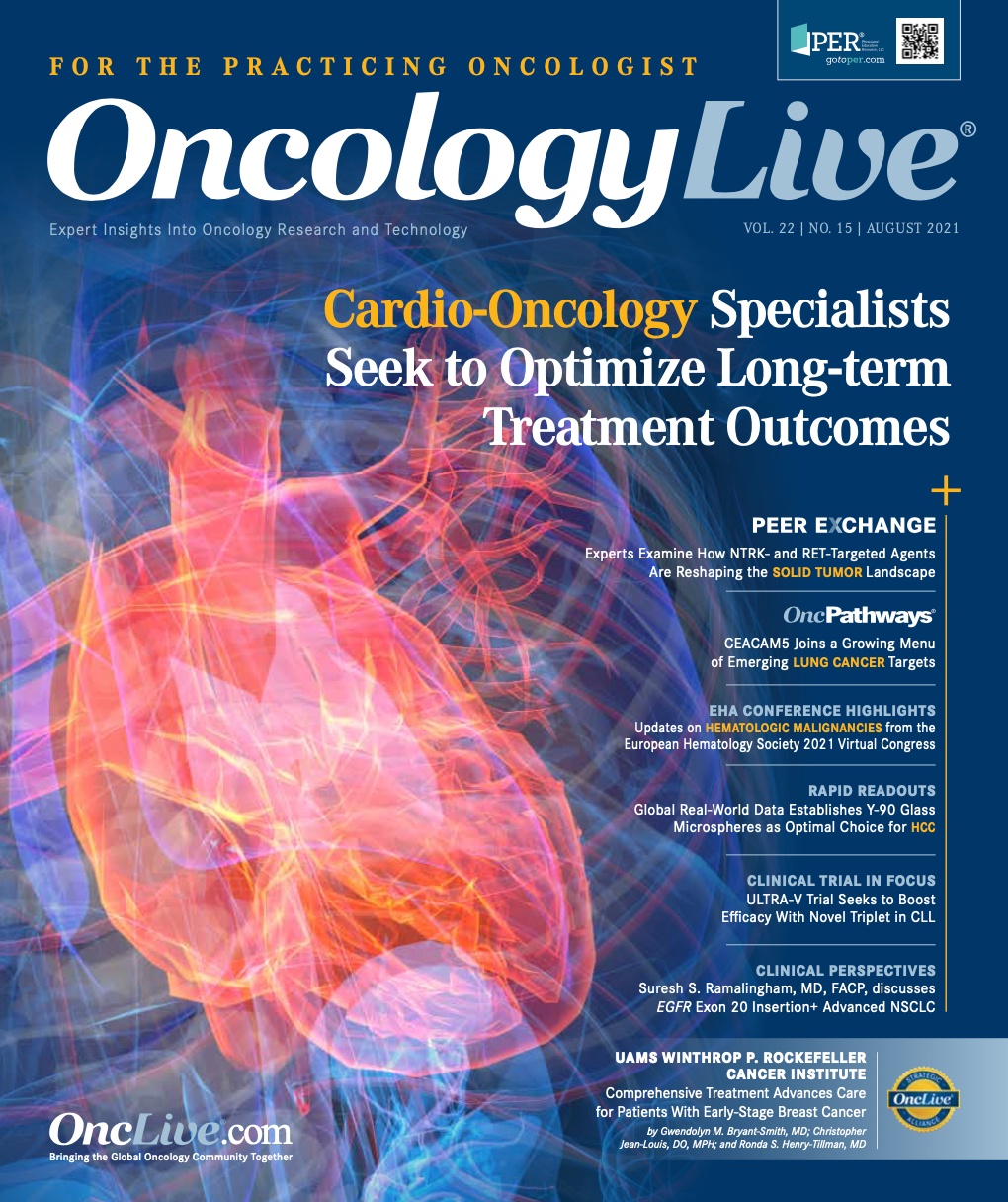Publication
Article
Oncology Live®
Cardio-oncology Specialists Pave Optimal Treatment Path for Patients With Cancer
Author(s):
The subspecialty of cardio-oncology has grown in recent years as improved cancer survival rates have expanded the population of long-term survivors with heightened risk of cardiovascular disease and drawn more attention to the need for preventive strategies and disease management.
Michael G. Fradley, MD

The subspecialty of cardio-oncology has grown in recent years as improved cancer survival rates have expanded the population of long-term survivors with heightened risk of cardiovascular disease (CVD) and drawn more attention to the need for preventive strategies and disease management. The toxic effects of cancer therapies on the heart and vascular system are significant contributors to morbidity and mortality, especially in patients who take anthracyclines or receive HER2-directed therapies but also for those treated with antiangiogenic therapies, tyrosine kinase inhibitors (TKIs), immune checkpoint inhibitors, targeted agents, and radiation (Table1,2). For many breast cancer survivors, the risk of death from CVD far exceeds the risk from their initial malignancy or recurrence.
Research on cardiotoxicity has flourished, as seen in the pages of specialized cardio-oncology journals and the growing membership of the International Cardio-Oncology Society (IC-OS). Yet clinicians say a great deal about cardiovascular effects is still unknown. Against the rapid influx of novel anticancer agents, it can be difficult to fund studies of older drugs, and basic issues such as a uniform definition of cardiotoxicity, the utility of biomarkers, and the effectiveness of commonly used cardioprotective therapies remain unresolved.
“As soon as you start feeling like you’re getting familiar with one drug, there’s a whole new class of drugs coming out that have their own potential impact,” said Michael G. Fradley, MD, an associate professor of clinical medicine and medical director of the Thalheimer Center for Cardio-Oncology at Penn Medicine in Philadelphia, Pennsylvania. “As much as we have made progress with cardio-oncology, we are still really in a very early phase of the specialty, and there are probably still more questions than answers.”
Cardio-oncologists use assessment tools such as heart screenings, cardiac biomarker testing, and imaging via echocardiography. They can provide cardioprotective agents, such as β-blockers, angiotensin-converting enzyme (ACE) inhibitors, and statins; treatments for heart failure (HF) and other conditions; and recommendations for exercise and dietary changes, dose modifications, and pauses in therapy.
Effects Across Drug Classes
The cardiotoxic effects of anthracycline drugs such as daunorubicin and epirubicin have been a primary focus of cardio-oncological research for decades. They can cause cardiomyopathy, increased risk of HF, left-ventricular dysfunction (LVD), and arrhythmia. Although the use of anthracyclines in breast cancer care has decreased over the past 15 years, they are still used to treat patients with breast cancer as well as those with lymphoma, sarcoma, and many pediatric malignancies. Anthracycline-induced HF has been described as a leading comorbidity in survivors of childhood cancers.4 The HER2-directed monoclonal antibody drug trastuzumab (Herceptin) has also been intensively investigated for cardiotoxic effects. It is associated with high rates of cardiac function declines and HF, with results from 1 retrospective study finding abnormal left ventricular ejection fraction (LVEF) decline in 43.9% (n = 179/408) of patients with breast cancer who had normal LVEF before treatment.5 More than 6 years after treatment, patients with breast cancer who developed cardiotoxicity during trastuzumab therapy had significantly lower LVEF, global longitudinal strain (GLS), and peak oxygen consumption than those who had not experienced earlier cardiotoxicity.6
Table. Cardio-Oncologic Outcomes Associated With Anticancer Therapies1,2

Virtually every type of cancer drug can affect the cardiovascular system. Traditional chemotherapies associated with CVD include platinum-based agents such as cisplatin that are linked to arterial vascular disease, venous thromboembolism, and systemic hypertension; and antimetabolites such as 5-fluorouracil, capecitabine, and cytarabine, which can cause cardiomyopathy, arterial vascular disease, and pericardial disease. Alkylating agents (cyclophosphamide), micro-tubule-binding agents (paclitaxel), and immunomodulatory agents (thalidomide; Thalomid) also have a variety of CV impacts.
Among targeted agents, drugs with antiangiogenic effects—the anti-VEGF therapy bevacizumab (Avastin) and TKIs such as sunitinib (Sutent) and sorafenib (Nexavar)—can cause hypertension and other effects. A meta-analysis of 77 studies of drugs target-ing the VEGF-signaling pathway noted severe hypertension in 7.4% of patients, arterial thromboembolism in 1.8%, cardiac ischemia in 1.7%, and cardiac dysfunction in 2.3%.7
“The biggest issue you may encounter is obviously hypertension, which will lead to heart failure,” said Daniel J. Lenihan, MD, professor of medicine and director of the Cardio-Oncology Center of Excellence at Washington University School of Medicine in St Louis, Missouri, and president of IC-OS. “It’s extremely common and depending on which drug you’re using it could [occur in] at least 50% of the patients or more.”
“The biggest issue you may encounter is obviously hypertension, which will lead to heart failure,” said Daniel J. Lenihan, MD, professor of medicine and director of the Cardio-Oncology Center of Excellence at Washington University School of Medicine in St Louis, Missouri, and president of IC-OS. “It’s extremely common and depending on which drug you’re using it could [occur in] at least 50% of the patients or more.”
Recent studies have highlighted the cardiotoxicity of the TKI ibrutinib (Imbruvica). In a 3-arm chronic lymphocytic leukemia (CLL) trial (NCT01886872), atrial fibrillation occurred in 17% of patients in the ibrutinib group (n = 182), compared with 14% in the ibrutinib-rituximab group (n = 182) and 3% in the bendamustine-rituximab group (n = 183); grade 3 or higher hypertension rates were 29%, 34%, and 14%, respectively.9 The 2 ibrutinib arms were associated with a 7% rate of death during treatment or within 30 days after treatment cessation, compared with a 1% rate of death in the control arm.
Grinding Through the Details
The data from the CLL trial and other findings recently prompted a call for the FDA to require studies of lower-dose ibrutinib treatments, which may be as effective as the approved label dosages.10 Fradley and other cardio-oncologists note that trial results presented at the 2021 American Society of Clinical Oncology (ASCO) Annual Meeting showed that acalabrutinib (Calquence) causes fewer AEs, including CV effects, than ibrutinib in patients with previously treated CLL while offering similar efficacy.11
The data from the CLL trial and other findings recently prompted a call for the FDA to require studies of lower-dose ibrutinib treatments, which may be as effective as the approved label dosages.10 Fradley and other cardio-oncologists note that trial results presented at the 2021 American Society of Clinical Oncology (ASCO) Annual Meeting showed that acalabrutinib (Calquence) causes fewer AEs, including CV effects, than ibrutinib in patients with previously treated CLL while offering similar efficacy.11
“A fair number of the drugs are being released into phase 1 and phase 2 Joerg Herrmann, MD trials without having the full characterization,” Herrmann said. “Some studies might have cardio-oncologist involvement, but it’s really hard to argue for that if you don’t even really fully know that molecule in terms of its AE profile. That is where the call for action would be, if there were something new; we could do it in terms of preclinical testing that is high throughput and reliable.”
With older drugs, pharmaceutical manufacturers have little incentive to fund new trials to study cardiotoxicities and may not want to advertise the drugs’ AEs, he said.
That said, investigators are continually working to identify the effects of specific drugs using registry data and meta- analyses. For example, a recent study used AE data from the FDA to investigate the effects of BRAF/MEK inhibitor combinations in melanoma patients.12 Compared with monotherapy, the combinations were associated with increased risk for HF (reporting odds ratio [ROR], 1.62; 95% CI, 1.14-2.30; P = .007), arterial hypertension (ROR, 1.75; 95% CI, 1.12-2.89; P = .02), and venous thromboembolism (ROR, 1.80; 95% CI, 1.12-2.89; P = .02). Results of the study also found higher rates of cardiovascular adverse events (CVAEs) for the combinations in a commercial claims database.
Figure. Proposed Monitoring and Treatment for Patients Undergoing Potentially Cardiotoxic Anticancer Therapy1

Immunotherapies are another area of interest. “Checkpoint inhibitors are associated with myocarditis, but they’re also associated with significant rhythm disturbances and worsening of atherosclerosis. Those conditions don’t really show up as a change in LV function necessarily; they show up as something else,” Lenihan said. In a meta-analysis of past clinical trials presented at 2021 ASCO, patients who received PD-1, PD-L1, and CTLA-4 inhibitors had increased relative risk (RR) of grade 3 to 5 CVAEs compared with those who received placebos or best supportive care (RR, 1.36; 95% CI, 1.06-1.73; P = .01).13 However, analyses of individual AEs such as arrhythmia, cardiac arrest, and HF did not identify significant additional risks.
According to a consensus article from the European Society for Medical Oncology (ESMO), many other therapies with cardiovascular effects include protease inhibitors (carfilzomib; Kyprolis), mTOR inhibitors (everolimus; Afinitor), histone deacetylase inhibitors (vorinostat; Zolinza), endocrine therapies (tamoxifen, letrozole), chimeric antigen receptor T-cell therapies (tisagenlecleucel; Kymriah), and retinoids (tretinoin).
Many patients receive multiple types of therapies, further complicating cardiac care. Lenihan recently saw a patient with sarcoma who was treated first with doxorubicin, followed by pazopanib, pembrolizumab (Keytruda) for 2 years, and finally a drug combination, each of which may have affected her cardiovascular system in different ways.
“What is it that you’ve got to worry about in all those situations?” he asked. “It’s very complex and you have to grind through the details. A typical cardiologist response is, ‘Oh, the ejection fraction is in the normal range, so we don’t have any issues there, just move on.’ That’s not adequate. You have to look through the details of noninvasive test measurements, through the history of cancer therapy, their vital signs, demographics, and everything.”
Cardioprotection Remains Controversial
Cardio-oncology care starts before cancer treatment with baseline measurement of LVEF and cardiac biomarkers, principally troponin levels but also natriuretic peptides such as B-type natriuretic peptide. Patients with preexisting CVD or risk factors may receive β-blockers, ACE inhibitors and angiotensin receptor blockers (ARBs). Statins are increasingly being given to prevent hyperlipidemia. But evidence for the benefit of cardioprotective drugs is mixed and their use remains controversial.
In the MANTICORE 101-Breast study (NCT01016886), the ACE inhibitor perindopril and β-blocker bisoprolol was found to protect against cancer therapy–related declines in LVEF in patients with HER2-positive early breast cancer who received trastuzumab, but trastuzumab-mediated left ventricular remodeling was not prevented.14 In recent findings from the PRADA study (NCT01434134), the ARB candesartan administered during adjuvant breast cancer therapy did not prevent reduction in LVEF at 2 years but was associated with modest reduction in left ventricular end-diastolic volume and preserved GLS.15 The investigators concluded that a broadly administered cardioprotective approach may not be required in most patients with early breast cancer without preexisting CVD.
The β-blocker carvedilol is a frequently used cardioprotective agent. In the OVERCOME trial (NCT01110824), patients with certain hematological malignancies who received carvedilol and the ACE inhibitor enalapril showed a significant reduction in a combined end point of death, HF, or final LVEF less than 45% at 6 months compared with placebo.16 However, results of CECCY (NCT01724450), which was the largest trial of β-blockers for prevention of anthracycline cardiotoxicity (n = 200), demonstrated that the drug had no effect on the incidence of early onset of LVEF reduction in patients with HER2-negative breast cancer.17 It did result in a significant reduction in troponin levels and diastolic dysfunction.
A few studies suggest statins may reduce CVAEs, but Fradley said those benefits are still unproven. Ongoing clinical trials investigating atorvastatin (Lipitor) include STOP-CA (NCT02943590) for patients with Hodgkin and non-Hodgkin lymphoma receiving doxorubicin and PREVENT (NCT01988571) for patients with breast cancer treated with doxorubicin and epirubicin.
Once cancer treatment begins, patients undergo periodic 3-dimensional echocardiography, cardiac MRI or other imaging, additional biomarker testing, and blood pressure monitoring. If the patient’s LVEF or GLS drops below cutoffs or signs of HF appear, a number of interventions are available. For example, ESMO guidelines state that a patient on anti-VEGF therapy whose blood pressure exceeds a threshold, such as 130/80 mm Hg, may be treated with dihydropyridine calcium channel blockers such as nifedipine or amlodipine and checked for other factors that contribute to hypertension. If the patient does not respond, the VEGF inhibitor dose may need to be reduced or discontinued.
The Benefit of Cardiooncologic Management
There is early evidence of the benefits of cardio-oncology care. When breast cancer patients receiving trastuzumab were assigned either to standard care or to cardio-oncological management, the latter group had fewer HF events.18 A log-rank test also showed a statistically significant difference in overall survival (OS) probability. The median OS with standard care therapy was 78.4 months (95% CI, 59-97) vs 98 months with management (95% CI, 89.7-106.2).
Results of a retrospective study of ponatinib for treatment of chronic myeloid leukemia found the incidence of CVAEs declined after investigators began making more cardio-oncology referrals, using a lower starting dose, and instituting early dose reductions.19 The TITAN study (NCT01621659) launched in 2012 is evaluating the effects of multidisciplinary team intervention on cardiotoxicity detection and management and on outcomes in patients with breast cancer or lymphoma.
Cardio-oncologists are confident their work makes a difference. Lenihan noted that CVD is the leading noncancer cause of death among cancer survivors and said cardio- oncological intervention is critical.
“If you simply manage somebody’s blood pressure and give them optimal cardiac-based therapy, you have a huge impact. The difference between doing that and not doing it, basically it’s a life and death thing,” he said. “It’s very likely they will get all the way through that treatment and they will end up with normal heart function at the end. If you don’t do those things they may make it only halfway through their treatment.”
Among the challenges cardiologists face is the shifting definition of cardiotoxicity. In addition to debating questions such as where to set the cutoff for abnormal LVEF during anthracycline and trastuzumab therapy, they are working to integrate the whole spectrum of newly discovered CV effects into their practices. Lenihan is a member of an international group that recently completed a broad literature review of cardiotoxicities—he hopes to see its proposed universal definition published soon.
Cardiovascular risk assessment is another area of active study. The European Society of Cardiology, in collaboration with IC-OS, last year published a set of risk-stratification tools, but cardiologists agree there is no generally accepted set of clear, standardized algorithms.2 They describe cardiac biomarkers as helpful in some scenarios and not others, and other potential useful technologies as not ready for clinical use.
“A lot still needs to be known in cardio-oncology, primarily in predicting who will develop cardiovascular disease and when. For predicting risk, in addition to genomics and precision medicine, artificial intelligence, particularly machine learning, is becoming of more interest in the field,” said Sherry-Ann Brown, MD, PhD, an assistant professor and director of cardio- oncology at Medical College of Wisconsin in Green Bay. Artificial intelligence tools are being developed for interpreting imaging and electrocardiograms, automating diagnosis, predicting HF risk, and other functions.20
Fradley said cardiologists also need more information about the underlying mechanisms of cardiotoxicity, which are unclear for many drugs. For example, understanding how Bruton tyrosine kinase inhibitors cause atrial fibrillation and whether it differs from nontherapeutic atrial fibrillation could allow physicians to use a different treatment approach.
“If we can understand how or why cardio-vascular disease happens, we’re going to be much better equipped at knowing how to treat it, or manage it, or even prevent it,” Fradley said. “It’s really drilling down from the observation that these things are happening to try to understand mechanistically why they’re happening.”
References
- Curigliano G, Lenihan D, Fradley M, et al; ESMO Guidelines Committee. Management of cardiac disease in cancer patients throughout oncological treatment: ESMO consensus recommendations. Ann Oncol. 2020;31(2):171-190. doi:10.1016/j.annonc.2019.10.023
- Lyon AR, Dent S, Stanway S, et al. Baseline cardiovascular risk assessment in cancer patients scheduled to receive cardiotoxic cancer therapies: a position statement and new risk assessment tools from the Cardio-Oncology Study Group of the Heart Failure Association of the European Society of Cardiology in collaboration with the International Cardio-Oncology Society. Eur J Heart Fail. 2020;22(11):1945-1960. doi:10.1002/ejhf.1920
- Bodai BI, Tuso P. Breast cancer survivorship: a comprehensive review of long-term medical issues and lifestyle recommendations. Perm J. 2015;19(2):48-79. doi:10.7812/TPP/14-241
- Bansal N, Adams MJ, Ganatra S, et al. Strategies to prevent anthracycline-induced cardiotoxicity in cancer survivors. Cardiooncology. 2019;5:18. doi:10.1186/s40959-019-0054-5
- Nowsheen S, Aziz K, Park JY, et al. Trastuzumab in female breast cancer patients with reduced left ventricular ejection fraction. J Am Heart Assoc. 2018;7(15):e008637. doi:10.1161/JAHA.118.008637
- Yu AF, Flynn JR, Moskowitz CS, et al. Long-term cardiopulmonary consequences of treatment-induced cardiotoxicity in survivors of ERBB2-positive breast cancer. JAMA Cardiol. 2020;5(3):309-317. doi:10.1001/jamacardio.2019.5586
- Abdel-Qadir H, Ethier JL, Lee DS, Thavendiranathan P, Amir E. Cardiovascular toxicity of angiogenesis inhibitors in treatment of malignancy: a systematic review and meta-analysis. Cancer Treat Rev. 2017;53:120-127. doi:10.1016/j.ctrv.2016.12.002
- Singh AP, Umbarkar P, Tousif S, Lal H. Cardiotoxicity of the BCR-ABL1 tyrosine kinase inhibitors: emphasis on ponatinib. Int J Cardiol. 2020;316:214-221. doi:10.1016/j.ijcard.2020.05.077
- Woyach JA, Ruppert AS, Heerema NA, et al. Ibrutinib regimens versus chemoimmunotherapy in older patients with untreated CLL. N Engl J Med. 2018;379(26):2517-2528. doi:10.1056/NEJMoa1812836
- Ratain MJ, Moslehi JJ, Lichter AS. Ibrutinib’s cardiotoxicity—an opportunity for postmarketing regulation. JAMA Oncol. 2021;7(2):177-178. doi:10.1001/jamaoncol.2020.5742
- Byrd JC, Hillmen P, Ghia P, et al. First results of a head-to-head trial of acalabrutinib versus ibrutinib in previously treated chronic lymphocytic leukemia. J Clin Oncol. 2021;39(suppl 15):7500. doi:10.1200/JCO.2021.39.15_suppl.7500
- Guha A, Jain P, Fradley MG, et al. Cardiovascular adverse events associated with BRAF versus BRAF/MEK inhibitor: cross-sectional and longitudinal analysis using two large national registries. Cancer Med. 2021;10(12):3862-3872. doi:10.1002/cam4.3938
- Xavier CB, Lopes CDH, Harada G, Katz A, Jardim DLF. Cardiovascular toxicity incidence following immune checkpoint inhibitors in randomized clinical trials: a systematic review and meta-analysis. J Clin Oncol. 2021;39(suppl 15):2636. doi:10.1200/JCO.2021.39.15_suppl.2636
- Pituskin E, Mackey JR, Koshman S, et al. Multidisciplinary approach to novel therapies in cardio-oncology research (MANTICORE 101-Breast): a randomized trial for the prevention of trastuzumab-associated cardiotoxicity. J Clin Oncol. 2017;35(8):870-877. doi:10.1200/JCO.2016.68.7830
- Heck SL, Mecinaj A, Ree AH, et al. Prevention of cardiac dysfunction during adjuvant breast cancer therapy (PRADA): extended follow-up of a 2×2 factorial, randomized, placebo-controlled, double-blind clinical trial of candesartan and metoprolol. Circulation. 2021;143(25):2431-2440. doi:10.1161/CIRCULATIONAHA.121.054698
- Bosch X, Rovira M, Sitges M, et al. Enalapril and carvedilol for preventing chemotherapy-induced left ventricular systolic dysfunction in patients with malignant hemopathies: the OVERCOME trial (prevention of left Ventricular dysfunction with enalapril and carvedilol in patients submitted to intensive chemotherapy for the treatment of malignant hemopathies). J Am Coll Cardiol. 2013;61(23):2355-2362. doi:10.1016/j.jacc.2013.02.072
- Avila MS, Ayub-Ferreira SM, de Barros Wanderley MR Jr, et al. Carvedilol for prevention of chemotherapy-related cardiotoxicity: the CECCY trial. J Am Coll Cardiol. 2018;71(20):2281-2290. doi:10.1016/j.jacc.2018.02.049
- Fabiani I, Cipolla CM, Colombo N, Cardinale D. Cardioncological approach for trastuzumab therapy in breast cancer patients with cardiotoxicity: impact on adherence and clinical outcome. Front Pharmacol. 2020;11:1190. doi:10.3389/fphar.2020.01190
- Chan O, Talati C, Isenalumhe L, et al. Side-effects profile and outcomes of ponatinib in the treatment of chronic myeloid leukemia. Blood Adv. 2020;4(3):530-538. doi:10.1182/bloodadvances.2019000268
- Lopez-Jimenez F, Attia Z, Arruda-Olson AM, et al. Artificial intelligence in cardiology: present and future. Mayo Clin Proc. 2020;95(5):1015-1039. doi:10.1016/j.mayocp.2020.01.038























%20(2)%201-Recovered-Recovered-Recovered-Recovered-Recovered-Recovered-Recovered-Recovered-Recovered-Recovered-Recovered-Recovered-Recovered-Recovered-Recovered-Recovered-Recovered.jpg?fit=crop&auto=format)
%20(2)%201-Recovered-Recovered-Recovered-Recovered-Recovered-Recovered-Recovered-Recovered-Recovered-Recovered-Recovered-Recovered-Recovered-Recovered-Recovered-Recovered-Recovered.jpg?fit=crop&auto=format)
